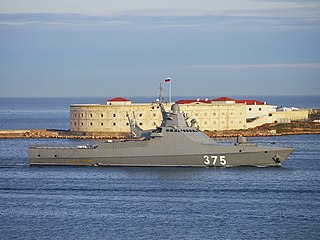
An anti-ship missile is a guided missile that is designed for use against ships and large boats. Most anti-ship missiles are of the sea-skimming variety, and many use a combination of inertial guidance and active radar homing. A large number of other anti-ship missiles use infrared homing to follow the heat that is emitted by a ship; it is also possible for anti-ship missiles to be guided by radio command all the way.

The Russian Navy is the naval arm of the Russian Armed Forces. It has existed in various forms since 1696; its present iteration was formed in January 1992 when it succeeded the Navy of the Commonwealth of Independent States.

The Black Sea Fleet is the fleet of the Russian Navy in the Black Sea, the Sea of Azov and the Mediterranean Sea. The Black Sea Fleet, along with other Russian ground and air forces on the Crimean Peninsula, are subordinate to the Southern Military District of the Russian Armed Forces. The fleet traces its history to its founding by Prince Potemkin on 13 May 1783 as part of the Imperial Russian Navy. The Russian SFSR inherited the fleet in 1918; with the founding of the Soviet Union in 1922, it became part of the Soviet Navy. Following the collapse of the Soviet Union in 1991, the Black Sea Fleet was partitioned between the Russian Federation and Ukraine in 1997, with Russia receiving title to 82% of the vessels.

The Ukrainian Navy is the maritime forces of Ukraine and one of the five branches of the Armed Forces of Ukraine.

The Slava class, Soviet designation Project 1164 Atlant, is a class of guided-missile cruisers designed and constructed in the Soviet Union for the Soviet Navy, and currently operated by the Russian Navy.

The Nanuchka class, Soviet designation Project 1234 Ovod, are series of corvettes built for the Soviet Navy and export customers between 1969 and 1991.

The Ropucha class, Soviet designation Project 775, is a class of landing ship built in Poland for the Soviet Navy. The ships were built in the Stocznia Północna shipyards in Gdańsk, Poland. They were designed for beach landings, and can carry 450 tons of cargo. The ships have both bow and stern doors for loading and unloading vehicles, and the 630 square metres (6,800 sq ft) of vehicle deck stretch the length of the hull. Up to 25 armored personnel carriers can be embarked.

Moskva, formerly Slava, was a guided missile cruiser of the Russian Navy. Commissioned in 1983, she was the lead ship of the Project 1164 Atlant class, named after the city of Moscow. With a crew of 510, Moskva was the flagship of the Black Sea Fleet and the most powerful warship in the region.

Ternopil (U209) was a Grisha-class anti-submarine corvette of the Ukrainian Navy. In March 2014, the ship was captured by Russian forces during the Crimean crisis.

Tsezar Kunikov (BDK-64), sometimes anglicised as Caesar Kunikov, was a Project 775, large landing ship of the Russian Navy. The ship was built in Poland, launched in 1986 and named after Soviet Naval Infantry officer Tsezar Kunikov. As part of the Russian Black Sea Fleet, it took part in the KFOR mission, the Russo-Georgian War, the Syrian Civil War, and the Russo-Ukrainian War.

The Matka class is the NATO reporting name for a group of hydrofoil missile boats built for the Soviet Navy. The Soviet designation was Project 206MR Vikhr. Following the 1997 Black Sea Fleet partition treaty all Black Sea Fleet Matka class boats were passed to the Ukrainian Navy.

Kommuna is a submarine rescue ship in service with the Russian Navy's Black Sea Fleet and the world's oldest active duty naval vessel.

The Karakurt class, Russian designation Project 22800 Karakurt, is a class of Russian corvettes which have been entering service with the Russian Navy since 2018.

Project 22160 is a series of large patrol ships being constructed for the Russian Navy. The vessels are primarily intended for duties such as patrol, monitoring and protection in open and closed seas. The first ship was laid down in February 2014 and joined the Russian Navy in December 2018. By January 2018, six ships were under construction. Between 2017 and 2022, four ships had been launched.

Shtil' was a Nanuchka-class corvette in the Soviet Navy and later the Russian Navy.

Vasily Bykov is a project 22160 patrol ship of the Russian Navy, of which it was the first ship built. It was laid down on 26 February 2014 on the Zelenodolsk Shipyard at Zelenodolsk in Tatarstan, Russia, and launched on 28 August 2017. Vasily Bykov was commissioned on 20 December 2018 in the Novorossiysk Naval Base at Novorossiysk, becoming part of the Black Sea Fleet.

The Russian warship Moskva, the flagship of the Russian Navy's Black Sea Fleet, sank on 14 April 2022 during the Russian invasion of Ukraine. Ukrainian officials announced that their forces had hit and damaged it with two R-360 Neptune anti-ship missiles, and that the ship had then caught fire. The United States Department of Defense later confirmed this, and Russia reported that the ship had sunk in stormy seas after the fire reached munitions onboard and they exploded.
















